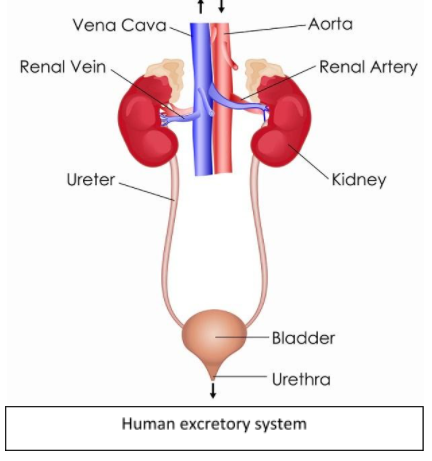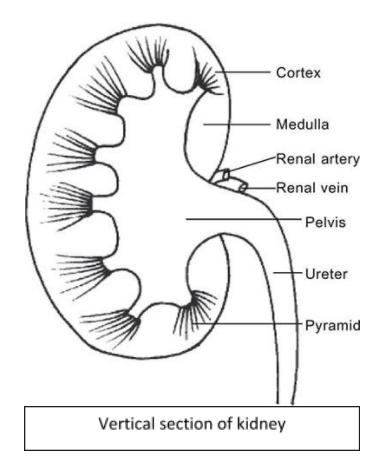
Give a brief account on the human excretory system. Add a note on the vertical section of the kidney.
Answer
577.8k+ views
Hint: Excretory system removes the metabolic wastes from body fluid or blood. It also removes excess water in the body. The main excretory organ in humans is the bean-shaped kidney which is present in a pair.
Complete answer: In humans, the excretory system removes nitrogenous waste along with other metabolic wastes from the body. It consists of few parts, viz. a pair of kidneys, renal arteries and veins, ureters, urinary bladder and urethra. The overall structure of the system is briefly discussed below.
1. The kidneys are bean-shaped organs. These are located on each side of the vertebral column. It performs the filtration blood to produce excretory fluid or urine. The structural and functional unit of the kidney is nephron. A nephron consists of: Bowman’s capsule, glomerulus, proximal tubule, Henle’s loop, distal tubule and collecting duct.
2. Renal arteries carry blood (to be filtered) to the kidneys from heart and renal veins carry filtered blood from kidneys to the inferior vena cava.
3. The kidneys open into the ureters at renal hilum. Ureters are tubes, each of which attach to a kidney and carries urine from kidneys to the urinary bladder.
4. Ureters open into the urinary bladder which is a muscular sac. These urine is stored temporarily. When filled, it contracts and passes the urine to the urethra.
5. A thin, fibro-muscular tube called urethra carries the urine from urethra to the exterior.

Note: A vertical section of kidney contains: renal cortex, renal medulla and renal pelvis. The outermost region of the kidney is the cortex which contains Malpighian corpuscles of nephrons. The inner region is called medulla. The cone shaped structures that make this part are called the renal pyramids. Collecting ducts open here. The pyramids are connected with the ureter by the renal pelvis.

Complete answer: In humans, the excretory system removes nitrogenous waste along with other metabolic wastes from the body. It consists of few parts, viz. a pair of kidneys, renal arteries and veins, ureters, urinary bladder and urethra. The overall structure of the system is briefly discussed below.
1. The kidneys are bean-shaped organs. These are located on each side of the vertebral column. It performs the filtration blood to produce excretory fluid or urine. The structural and functional unit of the kidney is nephron. A nephron consists of: Bowman’s capsule, glomerulus, proximal tubule, Henle’s loop, distal tubule and collecting duct.
2. Renal arteries carry blood (to be filtered) to the kidneys from heart and renal veins carry filtered blood from kidneys to the inferior vena cava.
3. The kidneys open into the ureters at renal hilum. Ureters are tubes, each of which attach to a kidney and carries urine from kidneys to the urinary bladder.
4. Ureters open into the urinary bladder which is a muscular sac. These urine is stored temporarily. When filled, it contracts and passes the urine to the urethra.
5. A thin, fibro-muscular tube called urethra carries the urine from urethra to the exterior.

Note: A vertical section of kidney contains: renal cortex, renal medulla and renal pelvis. The outermost region of the kidney is the cortex which contains Malpighian corpuscles of nephrons. The inner region is called medulla. The cone shaped structures that make this part are called the renal pyramids. Collecting ducts open here. The pyramids are connected with the ureter by the renal pelvis.

Recently Updated Pages
Two men on either side of the cliff 90m height observe class 10 maths CBSE

What happens to glucose which enters nephron along class 10 biology CBSE

Cutting of the Chinese melon means A The business and class 10 social science CBSE

Write a dialogue with at least ten utterances between class 10 english CBSE

Show an aquatic food chain using the following organisms class 10 biology CBSE

A circle is inscribed in an equilateral triangle and class 10 maths CBSE

Trending doubts
Which of the following does not have a fundamental class 10 physics CBSE

State and prove the Pythagoras theorem-class-10-maths-CBSE

Differentiate between Food chain and Food web class 10 biology CBSE

State BPT theorem and prove it class 10 maths CBSE

A Gulab jamun contains sugar syrup up to about 30 of class 10 maths CBSE

Write the difference between soap and detergent class 10 chemistry CBSE




